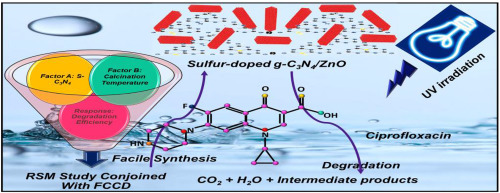当前位置:
X-MOL 学术
›
Environ. Res.
›
论文详情
Our official English website, www.x-mol.net, welcomes your
feedback! (Note: you will need to create a separate account there.)
Photo-induced degradation of bio-toxic Ciprofloxacin using the porous 3D hybrid architecture of an atomically thin sulfur-doped g-C3N4/ZnO nanosheet.
Environmental Research ( IF 7.7 ) Pub Date : 2020-01-20 , DOI: 10.1016/j.envres.2020.109154 Bramha Gupta 1 , Ashok Kumar Gupta 2 , Partha Sarathi Ghosal 1 , Chandra Sekhar Tiwary 3
Environmental Research ( IF 7.7 ) Pub Date : 2020-01-20 , DOI: 10.1016/j.envres.2020.109154 Bramha Gupta 1 , Ashok Kumar Gupta 2 , Partha Sarathi Ghosal 1 , Chandra Sekhar Tiwary 3
Affiliation

|
Ciprofloxacin is a pharmaceutically active compound which belongs to a class of micropollutants that cannot be removed using conventional water treatment systems. In this study, photocatalytic degradation using materials with high surface area and active sites was proposed to remove such contaminants. We demonstrated an easily scalable and simple synthesis route to prepare a 3D porous sulfur-doped g-C3N4/ZnO hybrid material, and the preparation process parameters were optimized using response surface methodology targeting Ciprofloxacin degradation. The hybrid material removed up to 98% of the bio-toxic Ciprofloxacin from synthetic water. The porous, defect engineered, thermally stable, and chemically interconnected hybrid material presented an 18 and 38% improved degradation efficiency compared to ZnO and sulfur-doped g-C3N4 (or S-C3N4), respectively. Based on our experimental results, an empirical relation correlating synthesis process parameters and degradation efficiency was developed using face-centered central composite design (FCCD) and response surface methodology (RSM). The current model can be used to design catalytic materials for removing bio-toxic and other micropollutants from water.
中文翻译:

使用原子稀硫掺杂的g-C3N4 / ZnO纳米片的多孔3D杂物结构,光诱导降解生物毒性环丙沙星。
环丙沙星是一种药物活性化合物,属于一类微污染物,无法使用常规水处理系统去除。在这项研究中,提出了使用具有高表面积和活性位点的材料进行光催化降解以去除此类污染物的方法。我们展示了一种易于扩展和简单的合成路线来制备3D多孔硫掺杂的g-C3N4 / ZnO杂化材料,并且使用响应表面方法针对环丙沙星降解优化了制备工艺参数。这种杂合材料从合成水中去除了高达98%的生物毒性环丙沙星。与ZnO和掺杂硫的g-C3N4(或S-C3N4)相比,这种多孔,缺陷工程,热稳定且化学互连的杂化材料的降解效率提高了18%和38%,分别。根据我们的实验结果,使用面心为中心的中央复合设计(FCCD)和响应面方法(RSM)开发了一种与合成工艺参数和降解效率相关的经验关系。当前模型可用于设计催化材料,以从水中去除生物毒性和其他微污染物。
更新日期:2020-01-21
中文翻译:

使用原子稀硫掺杂的g-C3N4 / ZnO纳米片的多孔3D杂物结构,光诱导降解生物毒性环丙沙星。
环丙沙星是一种药物活性化合物,属于一类微污染物,无法使用常规水处理系统去除。在这项研究中,提出了使用具有高表面积和活性位点的材料进行光催化降解以去除此类污染物的方法。我们展示了一种易于扩展和简单的合成路线来制备3D多孔硫掺杂的g-C3N4 / ZnO杂化材料,并且使用响应表面方法针对环丙沙星降解优化了制备工艺参数。这种杂合材料从合成水中去除了高达98%的生物毒性环丙沙星。与ZnO和掺杂硫的g-C3N4(或S-C3N4)相比,这种多孔,缺陷工程,热稳定且化学互连的杂化材料的降解效率提高了18%和38%,分别。根据我们的实验结果,使用面心为中心的中央复合设计(FCCD)和响应面方法(RSM)开发了一种与合成工艺参数和降解效率相关的经验关系。当前模型可用于设计催化材料,以从水中去除生物毒性和其他微污染物。











































 京公网安备 11010802027423号
京公网安备 11010802027423号